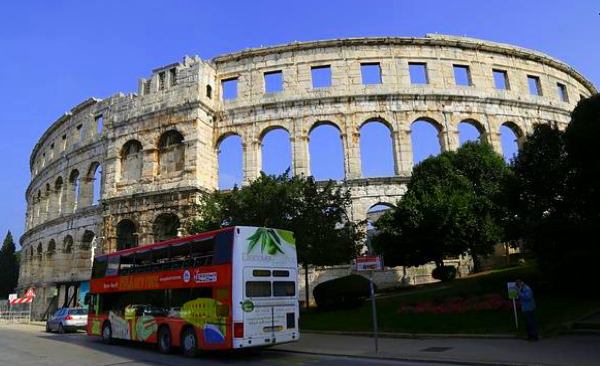The amphitheatre of Pula is probably the most important preserved ancient building in Croatia. The large arena from the 1st century AD is still very well preserved and can be visited today. In ancient times it held over 25,000 spectators and is still used as a stadium today. In the past, bloody gladiator fights and the like took place here, similar to the Colosseum in Rome. The ancient theatre is one of the most visited sights in Croatia.
This link provides online tickets for visitors to the Pula Amphitheatre

Arena Pula: Visitors to Pula can walk around the Arena free of charge. However, despite the large crowds, you should also go inside. Admission costs about 10 euros for adults. It is better to buy tickets online beforehand: Tickets for the amphitheatre are available online on the well-known ticket website Getyourguide: Click here
Opening hours of the Pula Amphitheatre 2025: The great sight of Pula can be visited every day of the year except on New Year’s Day (1.1.). In summer it is open from 8 am to 10 pm every day. In winter, depending on the month, it is shorter. However, the minimum opening hours are from 9 am to 5 pm.
Great dolphin tour from Pula: >>> More info and booking
Admission prices Arena Pula 2025: Adults pay the equivalent of about 10 euros. Children over 6 and students pay half price. Smaller children can visit the arena free of charge. Often very crowded, queues etc. It’s better to buy tickets in advance: The well-known ticket website Getyourguide sells tickets for the amphitheatre online: Click here
Location of Pula Amphitheatre: In the past, the Pula Arena was a few hundred metres outside the city, i.e. outside the city walls. Since the city centre is now larger, the amphitheatre is now in the centre of Pula, not far from the harbour. The ancient building can be reached on foot in a few minutes from today’s city centre. Due to its gigantic size, the amphitheatre has dominated the cityscape of Pula for almost 2000 years.
Construction of the Pula Amphitheatre: Under the first emperor (after Caesar) Augustus, a wooden arena was first built in Pula. Only a few decades later, the present arena was built of stone. The amphitheatre was opened around the year 80 AD under the Roman Emperor Titus. It is therefore almost 2000 years old.
Size Arena Pula: The Arena Pula has gigantic dimensions and can compete with a modern stadium. The ancient venue is not round but, like today’s stadiums, oval (about 130 metres long and a good 100 metres wide). On the side facing the sea, the walls are about 30 metres high. One above the other are 2 rows of 72 arcaded arches. Above this is another storey with rectangular windows (see pictures). On the side facing away from the sea, the theatre is not quite as high. Only 5 other amphitheatres in the Roman Empire were larger, including the Colloseum Rome. The arena had over 25,000 seats for spectators in ancient times. Today, somewhat fewer spectators are admitted for events.

Use of the Arena Pula in antiquity: It was mainly fights that took place. These were, on the one hand, fights between gladiators. Even more popular were the well-known fights between humans and large animals. But large battles also took place. Sometimes the interior was filled with water and sea battles were staged.
On this link you can get online tickets for visitors of the Pula Amphitheatre
State of Pula Amphitheatre today: It is probably the best preserved large amphitheatre from antiquity. Much better than the Colosseum in Rome, for example. Everything made of stone has been largely preserved. Other things are unfortunately no longer there. This includes, for example, the large tarpaulins to protect the spectators from the sun. Other things made of wood and other materials were unfortunately stolen over a long period of time, especially in the Middle Ages.
Today’s use of the Arena Pula: The arena is still used as a venue for events. On the one hand, there is culture in the Arena of Pula such as concerts. Stars such as Placido Domingo, Sting and Joe Cocker have performed here. The amphitheatre has good acoustics. Sports such as ice hockey games have also been played in the ancient stadium. Ancient films have also been shot here.
Croatia still has its own currency, the kuna. The amphitheatre of Pula is depicted on the 10-kuna note. This alone shows how important the arena is as a sight for Croatia to this day.
Great dolphin tour from Pula: >>> More info and booking